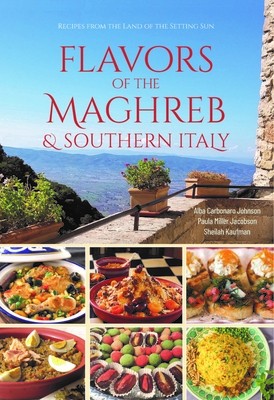
- We will send in 10–14 business days.
- Author: Alba Carbonaro Johnson
- Publisher: HIPPOCRENE BOOKS
- ISBN-10: 0781814367
- ISBN-13: 9780781814362
- Format: 17.6 x 25.2 x 1.6 cm, minkšti viršeliai
- Language: English
- SAVE -10% with code: EXTRA
Reviews
Description
The Arabic word Maghreb means "land where the sun sets." The Maghreb is a multicultural Mediterranean region of North Africa which includes Tunisia, Algeria, Morocco, Mauritania, and Libya. It is bordered by the beautiful Mediterranean Sea, and in ancient times, the Maghreb included Spain, Sicily, and Malta. The history of this region is completely different from that of the rest of Africa, and today's cuisine reflects those differences. It's an inviting cuisine, made with fresh local and seasonal ingredients, that carries a diversity of flavors and time-honored traditions to the Maghreb table.
Before the Arab conquest, the Phoenicians, Greeks, Romans, Byzantines, and later the Italians and French, colonized the Maghreb. Each new culture that entered the region left unique influences and together they created a multicultural cuisine using aromatic spices, fresh herbs, citrus, dried fruits, nuts, fresh fish, lamb, chicken, pasta, rice, and copious fresh vegetables. Ancient civilizations such as Phoenicians and Romans spread the cultivation of wheat. The Moors brought citrus and olives from Spain. The Berbers gave birth to couscous. Fennel, peas, and artichokes arrived with the Italian settlement, and the baguette, salad Niçoise, and mayonnaise were brought by the French when they colonized the area. Thus, the food of Maghreb became a mélange of Sicilian, French, Spanish, Arabic, and Berber cuisine.
This unique cookbook brings the colorful, aromatic foods of the Maghreb region to readers through over 100 authentic recipes. Chapters cover a range of options: Appetizers, Soups, Sides, Vegetables, Main Courses, Condiments, and Desserts. Also included are helpful chapters on the pantry essentials, herbs and spices that give Maghreb foods their distinct appeal.
Sample recipes:
- Crostini with Dill and Pecorino
- Spicy Cauliflower Minestra
- Couscous for Festive Occasions (Seffa)
- Lamb Chops in Dried Fig Sauce
- Baked Whole Bass with Chermoula
- Shrimp Speidini with Golden Breadcrumbs and Pistachios
- Rustic Pizza Stuffed with Red Onions, Pine Nuts, and Golden Raisins
- Broccoli Affogati
- Marzipan-Stuffed Dates
EXTRA 10 % discount with code: EXTRA
The promotion ends in 22d.16:12:38
The discount code is valid when purchasing from 10 €. Discounts do not stack.
- Author: Alba Carbonaro Johnson
- Publisher: HIPPOCRENE BOOKS
- ISBN-10: 0781814367
- ISBN-13: 9780781814362
- Format: 17.6 x 25.2 x 1.6 cm, minkšti viršeliai
- Language: English English
The Arabic word Maghreb means "land where the sun sets." The Maghreb is a multicultural Mediterranean region of North Africa which includes Tunisia, Algeria, Morocco, Mauritania, and Libya. It is bordered by the beautiful Mediterranean Sea, and in ancient times, the Maghreb included Spain, Sicily, and Malta. The history of this region is completely different from that of the rest of Africa, and today's cuisine reflects those differences. It's an inviting cuisine, made with fresh local and seasonal ingredients, that carries a diversity of flavors and time-honored traditions to the Maghreb table.
Before the Arab conquest, the Phoenicians, Greeks, Romans, Byzantines, and later the Italians and French, colonized the Maghreb. Each new culture that entered the region left unique influences and together they created a multicultural cuisine using aromatic spices, fresh herbs, citrus, dried fruits, nuts, fresh fish, lamb, chicken, pasta, rice, and copious fresh vegetables. Ancient civilizations such as Phoenicians and Romans spread the cultivation of wheat. The Moors brought citrus and olives from Spain. The Berbers gave birth to couscous. Fennel, peas, and artichokes arrived with the Italian settlement, and the baguette, salad Niçoise, and mayonnaise were brought by the French when they colonized the area. Thus, the food of Maghreb became a mélange of Sicilian, French, Spanish, Arabic, and Berber cuisine.
This unique cookbook brings the colorful, aromatic foods of the Maghreb region to readers through over 100 authentic recipes. Chapters cover a range of options: Appetizers, Soups, Sides, Vegetables, Main Courses, Condiments, and Desserts. Also included are helpful chapters on the pantry essentials, herbs and spices that give Maghreb foods their distinct appeal.
Sample recipes:
- Crostini with Dill and Pecorino
- Spicy Cauliflower Minestra
- Couscous for Festive Occasions (Seffa)
- Lamb Chops in Dried Fig Sauce
- Baked Whole Bass with Chermoula
- Shrimp Speidini with Golden Breadcrumbs and Pistachios
- Rustic Pizza Stuffed with Red Onions, Pine Nuts, and Golden Raisins
- Broccoli Affogati
- Marzipan-Stuffed Dates


Reviews